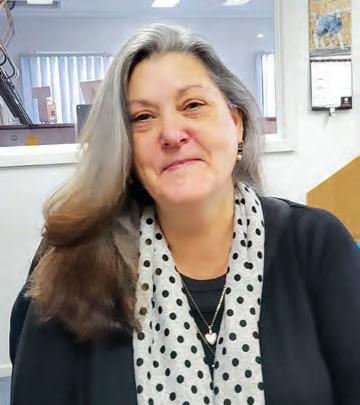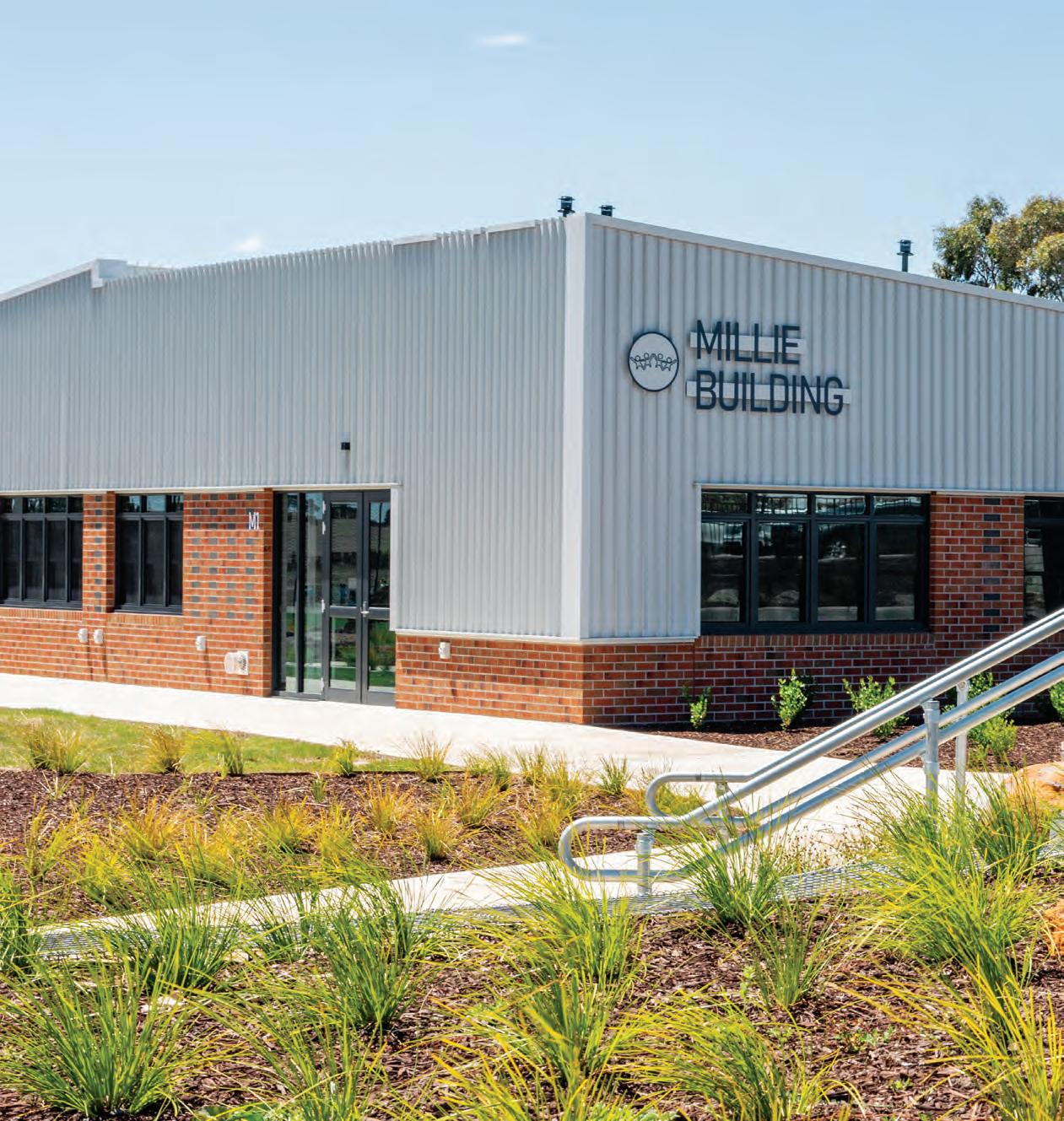
9 minute read
WALLS
Is it really just another brick in the wall?
WORDS JARROD REEDIE
The selection of internal walls and coverings products can shape a classroom and its learning environment. It’s imperative that an architect equips themselves with the best the market can offer.
Walls are used to divide spaces. In classrooms, these walls foster the educational growth of students in primary, secondary, and tertiary settings and therefore must be safe, sustainable and non-flammable.
The beauty of modern manufacturing means that these panels come in an abundance of different textures, finishes and shapes, allowing for them to reflect either the aesthetic or branding of a school or institution. Durable materials that can withstand high traffic environments seen in educational spaces should always be adopted by architects, particularly in places of specialised learning or communal areas like halls and gyms.
BILDSPEC
Bildspec’s Operable Walls range nurture the creative output of students through assisting in the creation of flexible learning spaces. The walls can divide or open out spaces when required and contain large format windows to provide maximum light transfer to allow maximum natural light. The high acoustic ratings met by Bildspec Operable Walls allow students to complete tasks without distraction from outside noise. This also gives architects the chance to implement them within areas of high activity, including halls and music rooms. Given that Bildspec is the first operable wall manufacturer in Australia, their expertise is seldom matched. The company says it sources its products from sustainable sources intent on responsibly harming timber, ensuring designers have peace of mind when utilising the company’s products.
PAGE 65 Kuring-gai High School, courtesy of Bildspec. BELOW & PAGE 67 Macarthar High School, courtesy of CSR/CEMINTEL.

BONDOR Bondor’s Equitilt composite panel possesses the ability to be installed as an interior lining panel or an exterior facade panel, coming in a suite of colorbond colours and finishes. The range comes in two options, with Equitilt offering high thermal performing Expanded Polystyrene with fire-retardant or Equitilt FlameGuard, which has a noncombustible Mineral Wool core.
Lightweight and efficient in comparison to its pre-cast concrete counterparts, Equitilt offers acoustic and fire safety qualities that make it suitable for educational settings, as seen within the Bunbury High School Cafeteria.
CEMINTEL
Cemintel’s Barestone panels are resilient to the challenges that arise from educational settings as well as being of low maintenance. The panels are durable and contain a minimalist aesthetic that allow it to blend in suitably amongst school paraphernalia. The panels feature Ceminseal waterblocking technology and are factory sanded, ready for installation with the trusted Cemintel Expresswall system.
Barestone panels can be adapted towards any project. As well as this, the products can be used with any other CSR products due to the company being part of the CSR Building Group. The company’s Surround and Territory products are other prefinished cladding options made suitable for educational spaces. Cemintel is an Australian manufacturer which makes for short lead times, with the simple setup ensuring a seamless process from beginning to end.
The selection of internal walls and coverings here provide architects with a wide range of products, finishes and colours. Modern pedagogy requires modern solutions for educational spaces, to provide students with spaces to learn, study and retain information.


DECO DecoPanel's aluminium flat sheet panels bring an air of contemporary to Australian learning spaces. The panels can be applied as a wall lining option or used as ceiling panels and are finished in a sublimated powder coated finish. Available in a range of timber, concrete or rust-look aesthetics, the smooth, contemporary wall panelling creates a low maintenance yet effective internal wall lining for use in an education setting.
Deco’s panels require little-to-no maintenance thanks to their durable finishes and can be personalised or branded towards the liking of a designer with over 30 DecoWood timber finishes and 12 DecoVogue concrete, rust, and stone finishes. They can be laser cut to any shape and can also be used with an acoustic lining. Non-combustible and easy to install, the flat sheet panels also come with a 12-year warranty, underlining their durability.
ELTON GROUP
According to Elton Group, its WoodWall product as a game changer. The timber veneer is available as a recut or natural species and pre-polished with a factory applied durable polyurethane coat, making it readymade for the challenges of learning environments head-on.
WoodWall is uniquely applied like a wallpaper to maximise space within classrooms. Its flexibility makes it suitable for curved walls, detailing, columns, and ceilings. Additionally, WoodWall holds a Group 1 fire rated surface product, making it suitable for classroom settings. WoodWall is claimed to be sustainable due to its timber qualities and is prefinished with a factory applied polyurethane polish. GYPROCK
The Rigitone range manufactured by Gyprock features acoustically outstanding perforated plasterboard. The panels are ideal for ceiling coverings and can be utilised in both small and large spaces, from classrooms to halls and libraries. Rigitone’s seamless bonds ensure a coherent covering that can be covered in a multitude of finishes.
The Rigitone ceiling panels contain ‘Active Air’ technology developed by Gyprock, which converts formaldehyde in the air to a non-harmful inert compound that is locked into the board, improving the air quality in the indoor environment for everyone using that space. Integrated lighting, ventilation and sound systems can easily be incorporated into the ceiling alongside Rigitone.
SINIAT
Siniat’s Trurock is a plasterboard internal wall solution that offers impact, water, and fire resistance without sacrificing on acoustic qualities. It has a high-density gypsum core, glass fibre reinforcement and recycled heavy duty purple liner paper.
Trurock is seen as a lighter alternative to fibre cement boards, with the Trurock HD range additionally mould resistant. Both products are available under the Siniat Carbon Neutral Opt-in program, certified by Climate Active and are GreenTag GreenRate certified. The plasterboard panels were recently utilised at Robina’s Arcadia College, with the school becoming the beneficiary of its impact resistance and sound insulating properties in learning spaces away from mainstream schooling.
So, as we’ve seen, internal walls come in all shapes and sizes and bricks are just one the many materials used across Australia’s diverse and growing education sector.

PAGE 69 Bondor’s Equitilt composite panel possesses the ability to be installed as an interior lining panel or an exterior facade panel, coming in a suite of colorbond colours and finishes.


SUPPLIERS Bildspec architectureanddesign.com.au/suppliers/bildspec Bondor architectureanddesign.com.au/suppliers/bondor Cemintel architectureanddesign.com.au/suppliers/cemintel Deco architectureanddesign.com.au/suppliers/deco-australia Elton Group architectureanddesign.com.au/suppliers/elton-group Gyprock architectureanddesign.com.au/suppliers/gyprock Siniat architectureanddesign.com.au/suppliers/siniat

Sound learning: Improving acoustic design in educational spaces & open-plan classrooms
The rise of open-plan classrooms has put the spotlight on the impact of poor acoustics on learning and teaching outcomes. Open-plan classrooms are often noisier than ‘traditional’ enclosed classrooms, exacerbating the adverse effects of uncontrolled noise on the performance of students and teachers.
Achieving optimal acoustic conditions for learning and teaching is a complex task that requires professional planning, and a deep understanding of all the relevant factors that contribute to acoustic quality within an interior environment.
Common acoustic issues in schools With other classes sharing the same space, open-plan classrooms tend to be noisier than your traditional classroom. A recent study of four different-sized Sydney schools found that most children were annoyed by the noise, and 50-70% of children surveyed said they could not hear their teacher very well, or at all, when the other classes were doing noisy group work activities.1
Modern classrooms suffer from other acoustic issues, including inadequate levels of reverberation (too high, or even too low in some cases), high levels of noise transmission between classrooms and external noise from the outside environment. Acoustic design requirements The National Construction Code details the minimum sound insulation requirements of walls and ceilings between different rooms and buildings. There is no specific Australiawide regulation or standard for the acoustic design of education environments, but industry guidelines such as the Association of Australasian Acoustical Consultants’ (AAAC) Guidelines for Educational Facilities provide a useful framework.
A holistic approach is needed that considers acoustical performance criteria for background noise (external noise intrusion and sound insulation) and reverberation time, which must both be satisfied to achieve a suitable learning environment. The AAAC provides a list of recommended internal noise levels and reverberation times for a wide range of educational spaces.
Implementing acoustic treatments Acoustic treatments help to absorb or diffuse sound to improve the acoustic quality of a space and are the most effective methods for controlling reverberation and noise transmission. These solutions can come in the form of acoustic wall panels, acoustic ceiling panels, ceiling clouds, acoustic foam and so on. All these products absorb or insulate sound and prevent it from transmitting back into the room or into an adjoining space.
Acoustic solutions for the modern classroom Siniat offers Createx and Creason - a range of specialty acoustic plasterboard linings with unique performance features ideal for educational settings, including supporting the current trend for open-plan teaching and study spaces. The brand offers perforated plasterboard solutions that can achieve the desired seamless appearance in open-plan designs while improving acoustic comfort.
Perforated plasterboard not only absorbs sound, but it also deflects and diffuses sound waves, leading to a much-improved sound quality and occupier experience. It provides the perfect acoustic solution for noisy indoor environments especially where human speech needs to be clearly heard and understood.
1 Mealings, Kiri. “Children struggle to hear and teachers struggle to teach in new open-plan learning environments.” Nomanis, Issue 4 (2017): 22-23.




SAVE THE DATE NOVEMBER 10, 2022 SYDNEY & ONLINE
2022 SUMMIT TOPICS
NCC changes for 2022: why have they not been adopted? Learn, design and adapt: Lessons on designing a disaster-resilient building How circular economy can drive greater sustainability and new business opportunities Creating social sustainability value chain – designing places that work well for people and the environment Social and affordable housing in Australia – where do we go from here?
The oldest and most respected sustainable built environment educational event in the country, the Sustainability Summit is Australia’s pinnacle of sustainable design, ideas and innovation.
With seven Formal CPD points on offer, hear from 30+ sustainability and industry leaders, and discover new ideas that directly impact sustainability and promote carbon-neutral design.










